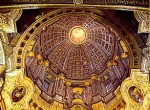(by Johanna Neyt for „The Vienna Review“, June 15, 2011)

The ceiling of the Jesuit Church in Vienna contains masterpieces of trompe l’oeil fresco painting by Andrea Pozzo, c.1703, as well as faux marble typical of high Baroque
Verdi’s Requiem echoes through the magnificent spaces of the Jesuitenkirche as the St. Augustine Choral Society works miracles.
It was a warm Saturday evening in May when I met my friends on the terrace of Inigo on Ignaz Seipel-Platz, already 2/3 full at just 18:00.
“Doing well by doing good,” one of my friends whispered impishly. This is a place where unemployed people can train to be chefs and wait staff, and within two years, be launched into a working life. Over its 19 years of operation, the food has only gotten better, and especially in the nice weather, tables are in hot demand.
We ordered some wine, gazing out languidly over the square at the soaring lines of the Jesuit church – also called the “University Church” for its one-time neighbour – whose twin onion towers rise high above neo-classical inset columns, niches of opulent statuary and tall leaded, the façade an unconventional configuration of early baroque.
It’s an odd mixture of elements really, yet somehow convincing, in sync with centuries of architecture on all sides.
While we were waiting for our dinner, the long outdoor tables began to fill with choir members and musicians who were taking a last break between rehearsal and performance. Someone passed just behind me; it was Andreas Pixner, the director of the Choral Society of St. Augustine who leaned down to greet us. Everyone looked excited, but no one was drinking; this was a big event – the 65 singers and 55 musicians – that had taken months and months of rehearsals. A choir member, who is also a violinist from the Symphony joined us at the table.
“It’s going to be very loud,” she warned us. “The church may be too small for all this sound…” She didn’t look all that worried. So neither were we.
While more and more nicely dressed people entered the church, some other friends joined us at the table. After we had a cup of coffee we decided to go and find our places in the church.
Inside the massive wooden doors, we waited as our eyes adjusted from the bright sunshine to the subdued lighting of the interior. Gradually, the details took shape: the twisting spiral columns of blue marble against panels of pink, sculpted scenes and statuary exploding in extravagant gold leaf from the layers of the polished wood pulpit.
The Jesuitenkirche is like a stage set: Most of the marble is “ersatz” painted on simpler stone; allegorical ceiling frescoes are trompe l’oeil, painted to fool the eye. Still, the effect is astonishing and overwhelming, a masterpiece of 18th century high baroque, whose opulent interior seemed to be the perfect setting for this large ‘Catholic Theater.’
We had just found our seats when the small army of musicians entered, took their places, and the music began. This Requiem, the traditional sequence of the Latin funeral rite, is written by one of Italy’s greatest opera composers of the nineteenth century, Giuseppe Verdi. As in his opera’s, the melodies are sublime, the rhythms are vigorous and the contrasts are dramatic, bombastic, powerful, or intimate and touching.
The terrifying “Dies Irae” that introduced the rite, explored the feelings of loss and sorrow as well as the human longing for forgiveness and mercy. From the galleries of two facing chapels, the four remote trumpets resounded over the room, the heralds of the Last Judgment. The piece reached its climax when the choir began to compete with the powerful orchestra, each trying to top the other. These are extraordinary musicians, the Choral Society of St.Augustine, one of Vienna’s oldest church choirs, and a hand-picked orchestra to match. Such a sound… I thought, God’s music at its best.
It was the last Sunday in January 1993. The choir gathered on the first floor of the Augustinian Cloister adjoining the Hofburg to rehearse for the 11 o-clock Mass, as they had done every Sunday and holiday for decades. The St. Augustine Choir was an institution in Vienna, that seemed to have always existed and always would.
On that particular day, an Augustine father entered the room and informed the singers and the director that their celebration of the Holy Mass wouldn’t be necessary, as a different ensemble had been signed on for ‘now and the following’ Sunday.
The musicians stood there, stunned. Then, some weeks later, the choir was told it would be welcome to sing again, but under new management and without Professor Friedrich Wolf, the St. Augustine father who made the outstanding chorus what it was. The choir saw only one way: they left the Augustinian Church and went into exile with him at their head.
Now a group of more than seventy choir singers was suddenly on the street. Most had been members for years, in many cases for decades, and were suddenly without a church home, without a ‘venue,’ or any financial means. But most of all they were without their music. The scores for choir and orchestra had always been stored by Wolf in the St.Augustine Cloister behind lock and key and now they were inaccessible.
Finding a new church home was not so easy; they received many invitations, from the St. Rochus Church in the 3rd district, St. Georg in Kagran and soon the Votive Church, the Maltese Church and the Minoritenkirche. But audiences had to be won over. 1993 saw a Pontifical Mass at the Klosterneuburg abbey church, two performances of Dvorák’s Mass D major, and the European premier of Richard Bing’s Missa,that they recorded on CD. But it perhaps the broadcast of their performance for the 1993 “Licht ins Dunkel” Christmas Show, that convinced the public. By the end of 1994, they were alternating Sundays between the Minoritenkirche and the Jesuitenkirche, which then, in 1995, became their permanent home. …having survived by its own power, motivation and enthusiasm.
I returned from my thoughts as tenor, Oliver Kook began his solo aria, “Ingemisco” and his luminous voice radiated hope for the sinner who asked for the Lord’s mercy. The color of the score and the opera-like treatment is unusual for a requiem. Since the first performance in 1874, written by Verdi in honor of the deceased Italian poet Manzoni, the piece has caused a stir, only gradually establishing itself as one of the most important settings of the Christian funeral service. The operatic range of the music is also reverential, a prayer as the confirmation of faith.
The joyful “Sanctus” (a complicated eight-part fugue scored for double chorus) began with a brassy fanfare to announce him “who comes in the name of the Lord” and lead into an angelic “Agnus Dei” sung by the female soloists, Cornelia Horak (sopran) and Gabriele Sima (Mezzosopran), together with the chorus. Finally the “Libera me,” the oldest music by Verdi in the Requiem, interrupted. Here the soprano cried out, begging, “Deliver me, Lord, from eternal death … when you will come to judge the world by fire.”
And suddenly, all was still. No one moved; the audience sitting still, as though stunned, moved beyond words. It was several moments before anyone clapped, a few hands here, then there, then suddenly in a flood. Waves of recognition washed over the crowd, and awe at the astonishing privilege of being present at such a moment, to have heard such a sound. The church responded as one.
As we left the church, we looked at each other and realised that we had just experienced something beyond anything we had known, something transcendental, created by man. Is this, I wondered, what people meant by an encounter with the divine?
